Quickstart
Make sure to read the regulatory and safety notices first.
You can start testing in just a few seconds:
- Switch on your Pockethernet. The Power LED will come on.
- Open the Pockethernet 2 App: iOS downlad | Android download
- Tap the "Connect" button in the App. No Bluetooth pairing is required.
- Select measurements and press "Measure"
- Review the results and optionally save them in the "Reports" tab
The device
Power button
When the device is powered off, press the power button until the Power LED becomes on.
When Pockethernet is powered on, the button does this:
| Button press | Action |
| Long (at least 2 sec) | Switches the device off |
| Short (<1.5sec) | Starts the Quick test function |
| Two quick presses | Switches the Flashlight function on or off |
| Very long (>8 sec) | Resets the device |
Power LED
When the device is powered on:
| Power LED color | State |
| Battery charge level > 50% | |
| Battery charge level between 30%-50% | |
| Battery charge level below 30% | |
| Battery fault |
USB cable connected for charging:
| Power LED color | State |
| Battery charging | |
| Fully charged | |
| Battery / charging fault |
When a USB cable is connected for charging while the device has been switched off, it will enter a charging standby mode indicated by a "breathing" power LED. In this state, you need to press the power button to actually turn the device on which is indicated by a solid LED color.
Network, Link, Cable LEDs
For the description of these, please see the section Quick test function
Connectors
The Ethernet port is for connecting to Ethernet cables and networks
The USB-C port is used for charging and wired software updates
The 3.5mm jack connector is reserved for future accessories
Flashlight function
With Pockethernet powered on, press the power button two times quickly to turn the flashlight function on or off. This will make all 4 LEDs light up with a bright light color. You can use it to locate cables and port in dark places like behind a rack or under a desk.
The app
The Pockethernet app allows to conduct tests and save the results as report The app consist of three main sections: Test, Report and Tools
Test tab
- The test tab has a separate row for each measurement
- You can expand and close the detail section of a test by clicking on the row
- The switch icon in each row header represents 4 possible states
-
- Measurement not selected to run
- Measurement selected to run
- Measurement in progress
- Measurement finished and it's results OK:/
All performed tests with a green or red indicator will be included in the report. If you want to exclude a test from the report, disable the test.
If you want to re-run a single test, deselect and select it again and press the Measure button.
If you long press the Measure button, test will be repeated with the following logic: If only the Wiremap test (an no other tests) has been run previously, then Wiremap will be repeated. If any other tests than Wiremap have been run previoulsy, all of those will be repeated but not the Wiremap. The rationale is that for the Wiremap test, you need the the wiremap adapter attached, so you either want to perform Wiremap or Network tests.
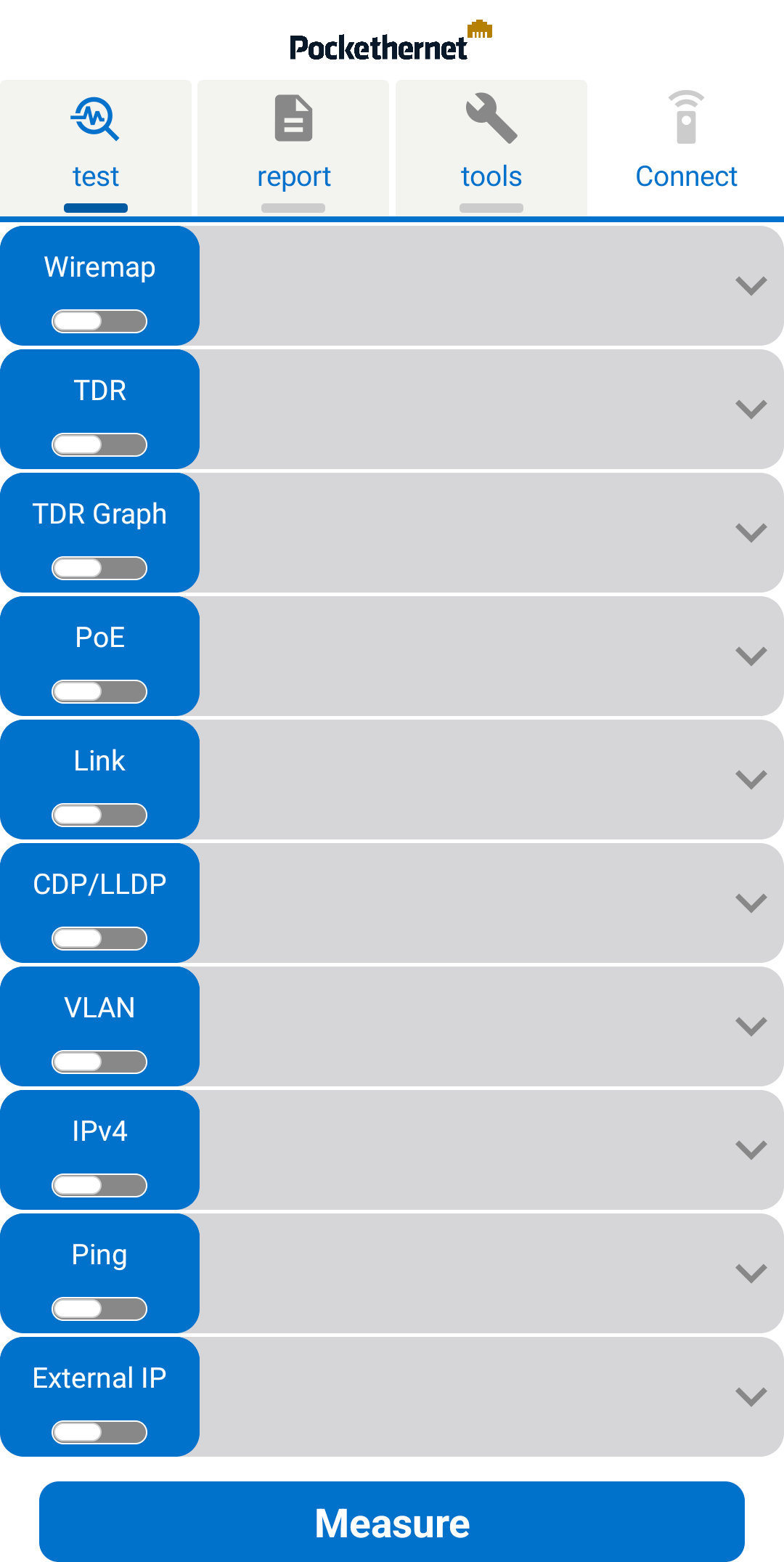
Report tab
The report pane allows you to create and save new reports or list, review and export the already existing ones.
Here's sample report PDF.Save report
Here you can create a report of the measurements performed in the test tab. All tests which are red or green in the test tab will be included. You can add additional details about the measurements such as:
- The user performing the tests
- Address, Location, Port ID
- Comment
- Add a relevant photo
These will all be included in the report.
The "Tag" field is a special field as it will not only be included in the report, but also in the filename of the generated PDF document. You can use it to quickly identify a measurement or report. If you don't need too much detail about the measurement, specifying a tag may be enough for identification.
The filename under which the report will be saved is:
"Pockethernet <Date> <Time> - <Tag>".pdf
The report can be viewed directly, shared via any application that supports receiving files, or saved locally on your device.
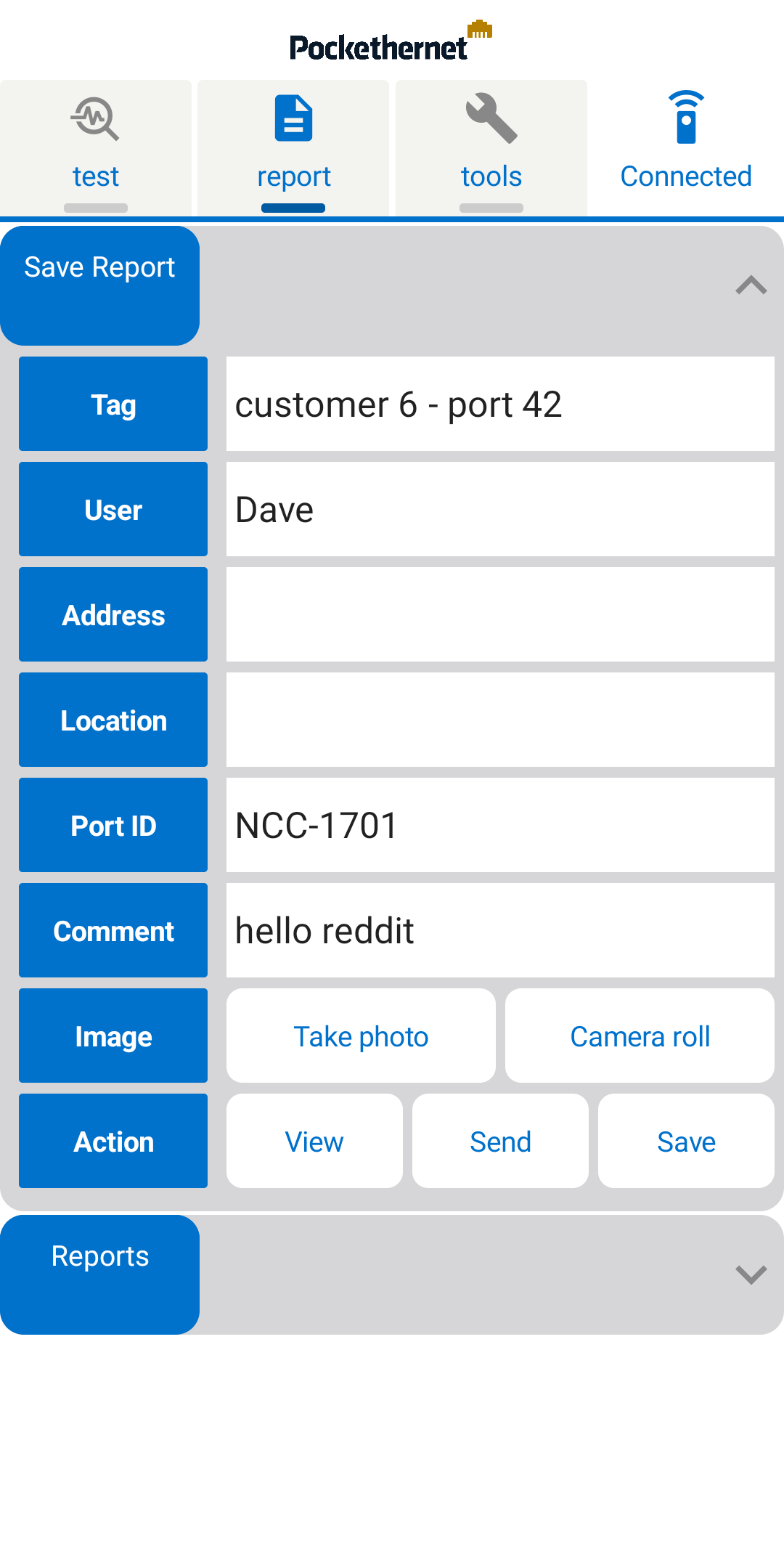
View reports
The View report subsection lists all your previously saved reports. Below the name of the report, you have four options in the "Action" row:
- View: Opens the report
- Send: Send the report via another application
- Delete: Delete the report from storage
- Select: Select the report to be included in the combined report
There are two batch export options on the bottom of the report list:
- Combined PDF: This creates a single PDF document from all reports selected above
- All reports as ZIP: This creates a ZIP file all all reports that are stored in the app. It will include the PDF files, the attached images as JPEG files and the raw measurement data in JSON format.
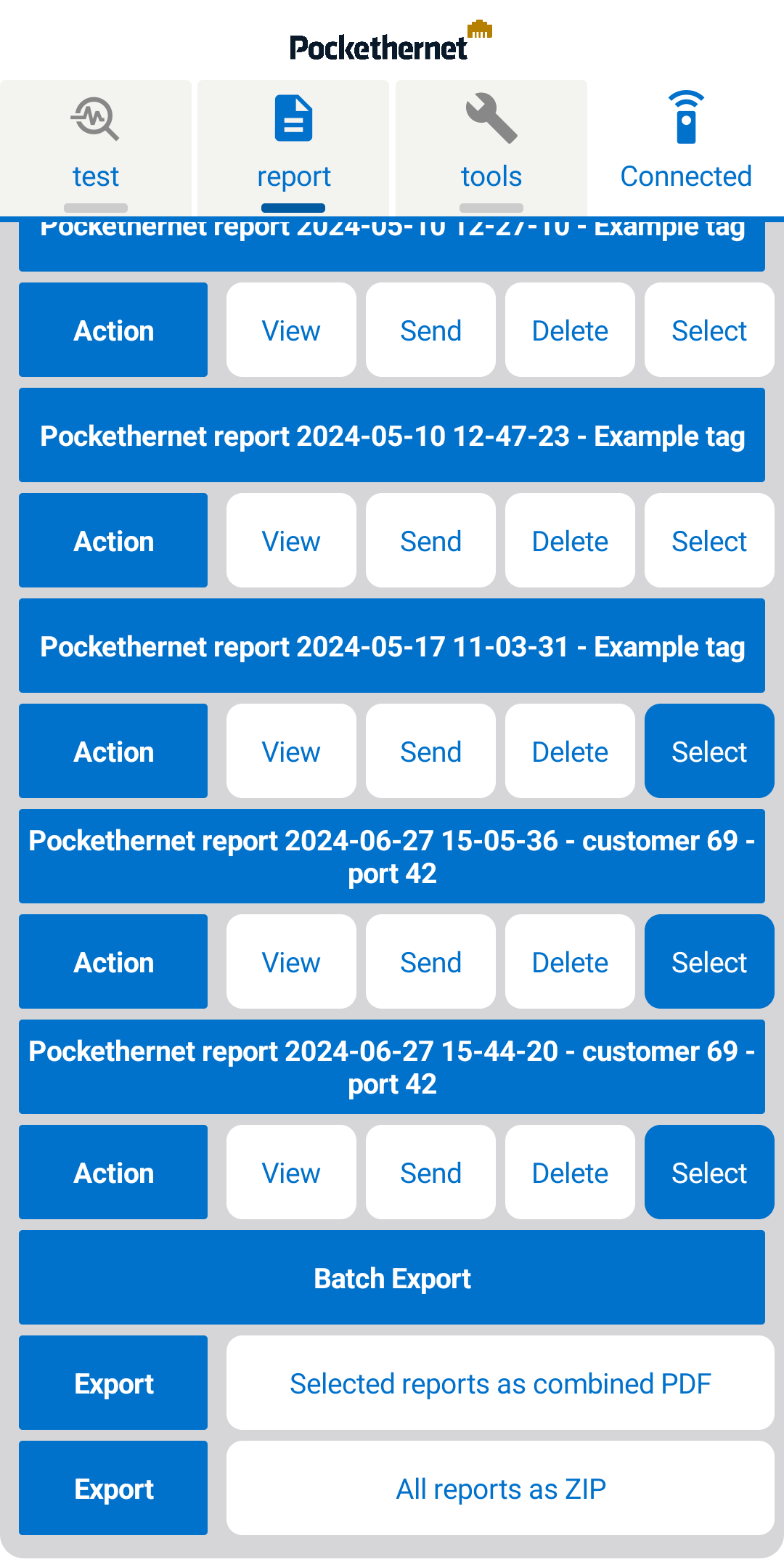
Tools tab
The tools tab contains tools, settings and informations.
Cable toner
The toner function allows identification and tracking of cables via an electronic signal that can be picked up with a tone probe. You can use it to identify individual cables in a bundle, identify individual wire pairs and track their path in culverts and walls. You can select on which wire pair the signal should be transmitted, which tone should be used at what volume. You can use any analogue tone probe to pick up the signal.
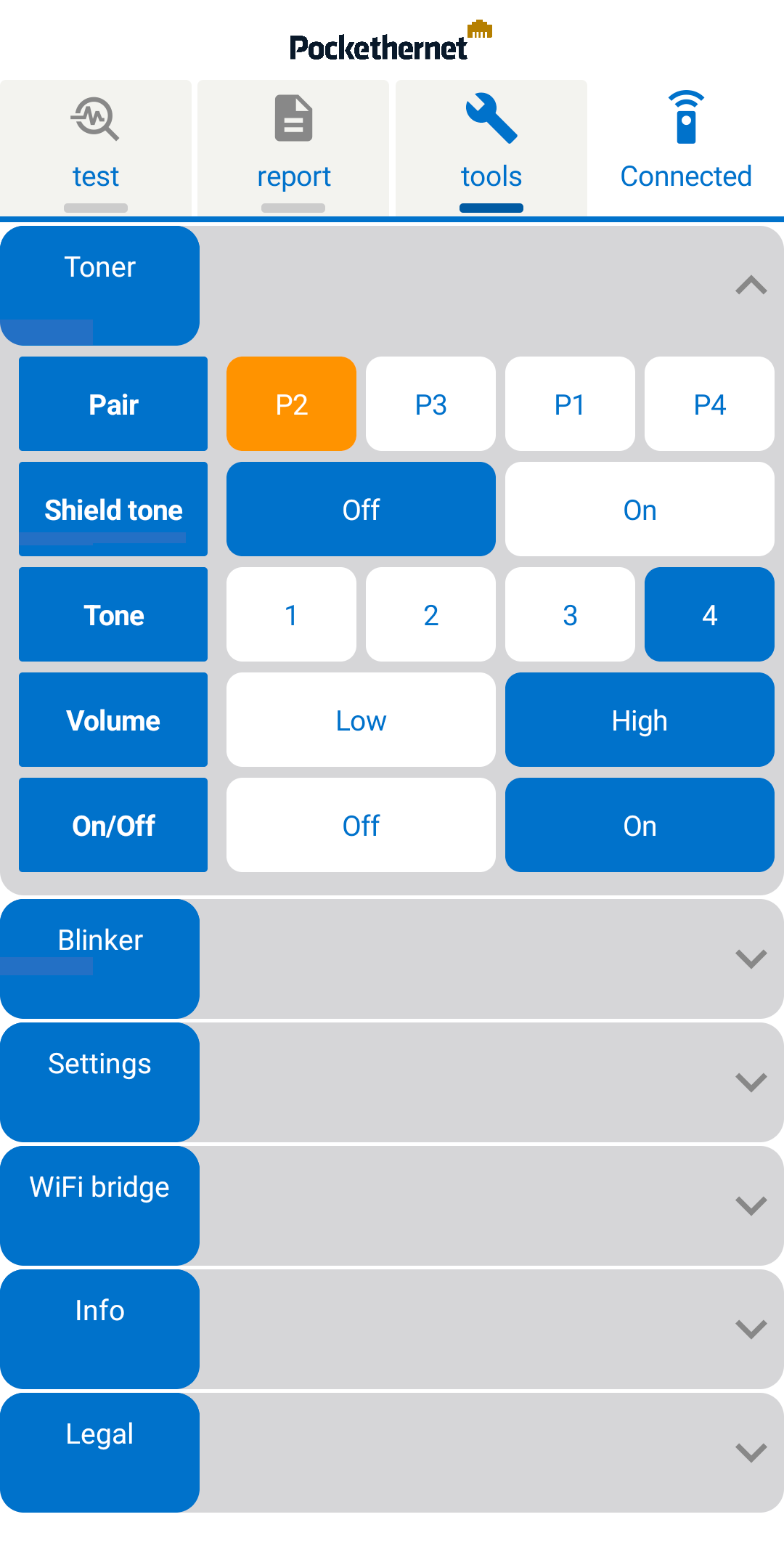
Port blinker
You can use the port blinker function to quickly identify a connection to a switch or router.
Set up the connection parameters and either set to "On" for a constant link or to "Blink" and look for the Link LED on the switch.
When using the Blink function, Pockethernet will repeatedly bring a link up and down, making the Link LED blink.
For switches which use a different color for low-speed links (e.g. orange instead of green), you can set the link speed to 10/100 Mbit so that it's even more easy to identify the connection.

Settings
Here you can set the following general settings:
TIA: Set the color scheme and pair numbering according to the TIA-568 A or B standard
Units: Distance units for the TDR measurements
NVP: Set the NVP of the cable use are using for more accurate TDR results
Custom MAC: You can set a custom MAC address to be used by the Pockethernet device during Ethernet communication in case it is needed for e.g. access control reasons
Report logo: Add your own logo to the top left corner of reports generated. The recommended size is 1013x200 pixels.
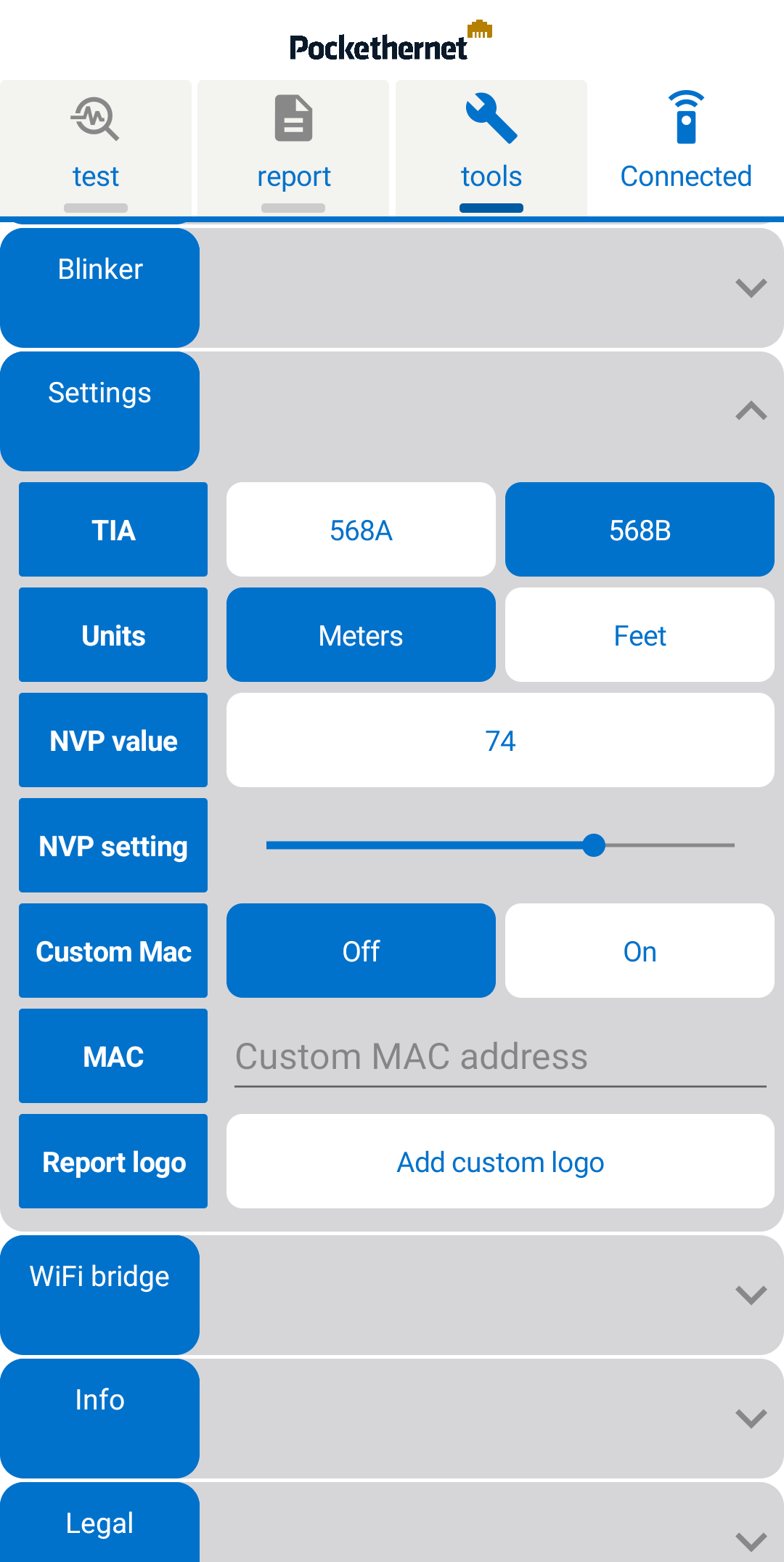
WiFi bridge ( beta, experimental function)
The WiFi bridge function allows you to use Pockethernet as a mobile WiFi router which creates a transparent WiFi bridge to the Ethernet network.
This allows you to connect WiFi devices (e.g. your smartphone) "directly" to the Ethernet network.
Using this functionality, you can do further network level tests with other apps (e.g. testing networked printers, using network discovery apps, etc.) or set up devices (e.g. provision network devices or IP cameras).

Pockethernet device information
You can check the device serial number, default MAC address and firmware version.
Firmware upgrade: You can check for available firmware upgrades and apply them to the device. The Pockethernet device needs to be connected to an Internet connection via Ethernet for it to be able to download the upgrade image.

Measurements
Wiremap
Wiremap adapter required for the test:
The wiremap test requires the Pockethernet Wiremap Adapter to be connected to the other end of the tested cable run. Pockethernet is only compatible with its own wiremap adapters. If you perform a wiremap measurement against a connected Ethernet port, you will probably get short circuits displayed because of the Ethernet port termination transformer.
The wiremap test determines (by transmitting signals through each wire) if a pin on a connector is connected to the correct pin at the other end.
The status summary line tells you the type of calbe connected or the fault.
These configurations will be listed as OK with a green indicator:
- 4-pair straight through
- 4-pair full crossover (all 4 pairs crossed)
- 4-pair mixed crossover (2 pairs crossed, 2 pairs straight)
- 2-pair straight
- 2-pair crossover
Any other configuration will be marked as Miswire with a red indicator
The graphical wiring diagram shows the status of each individual wire: the corresponding connected pin is shown on the right side. In case of short circuits between the wires, these are shown with a red vertical connection, opens are shown in the middle as a break in the line.
The pair numberings and colors are based on the TIA colour scheme selected in the tools ⇒ settings menu. To get a valid result, you need the have the Pockethernet terminator adapter with the "Wiremap" side attached to the other end of the cable. Pockethernet is only compatible with the wiremap adapter that came with Pockethernet.
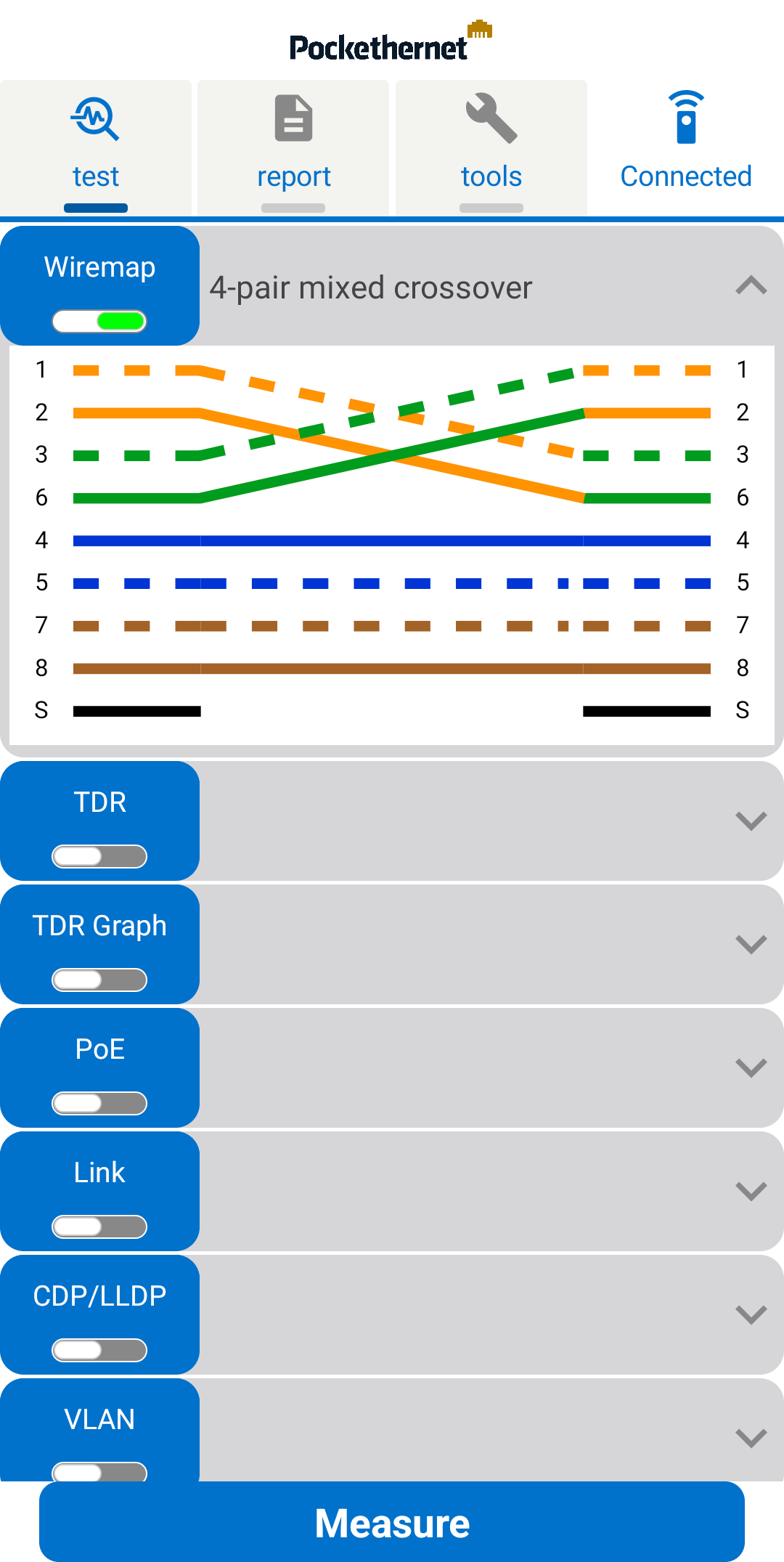
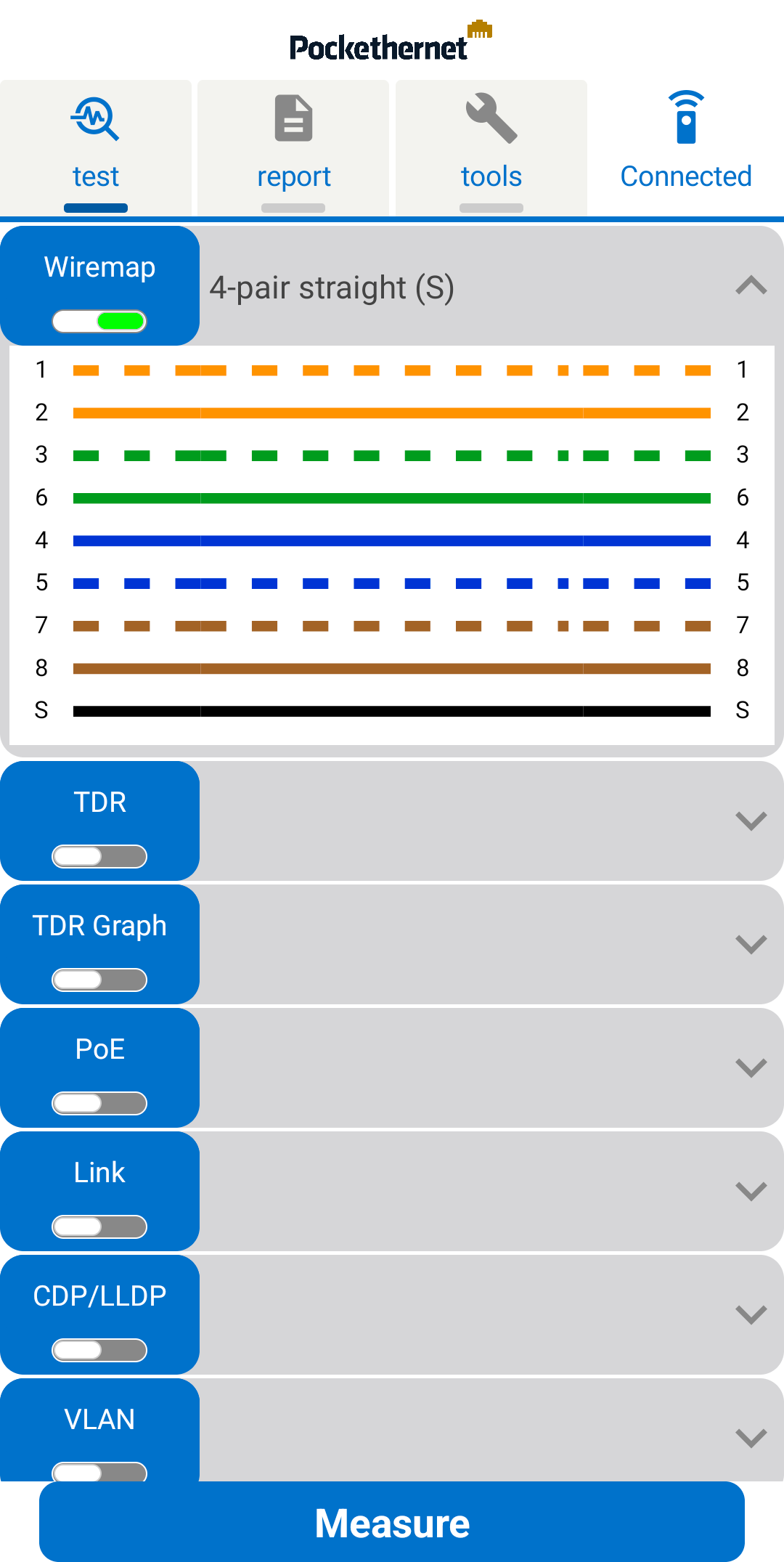
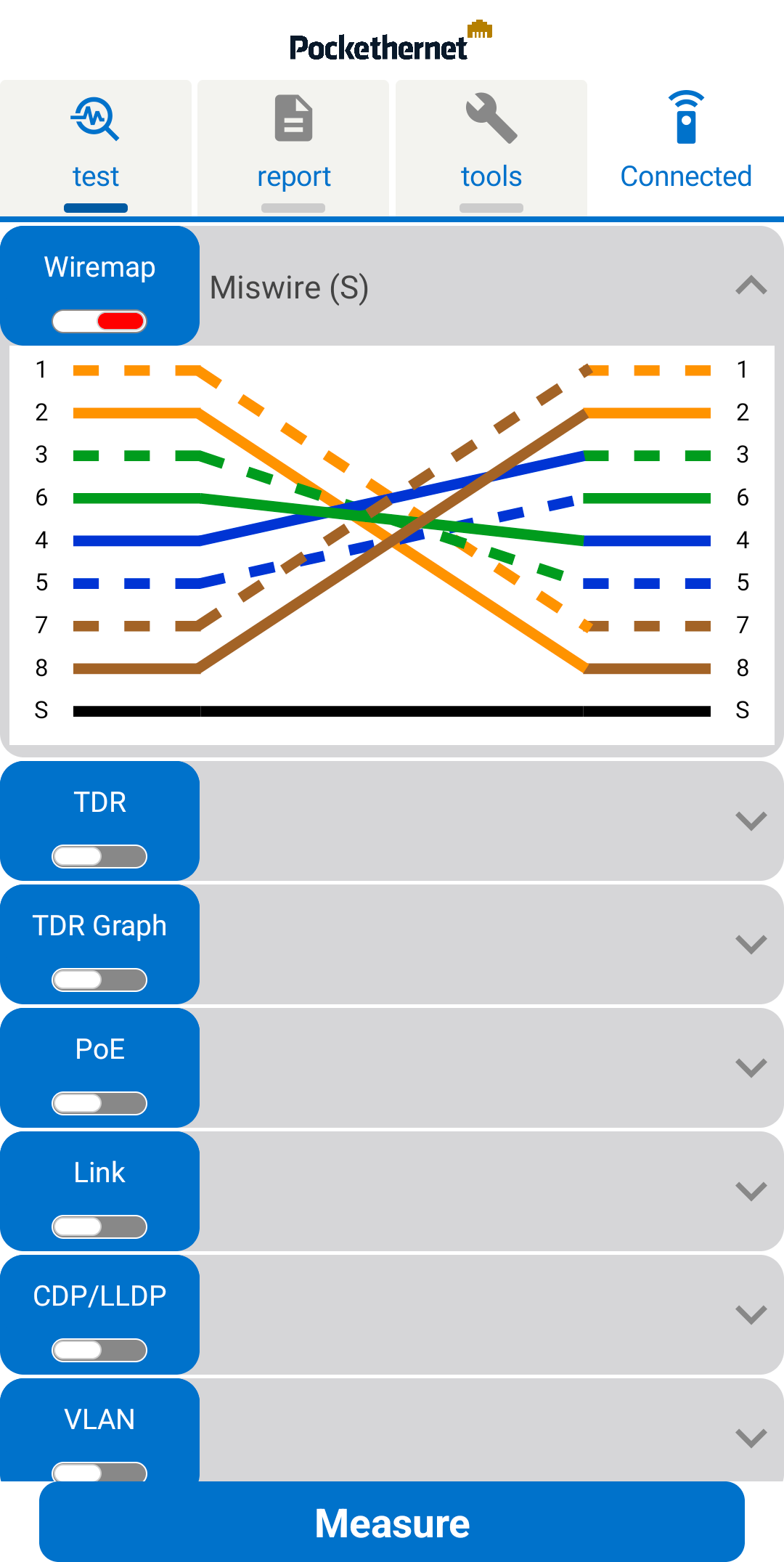
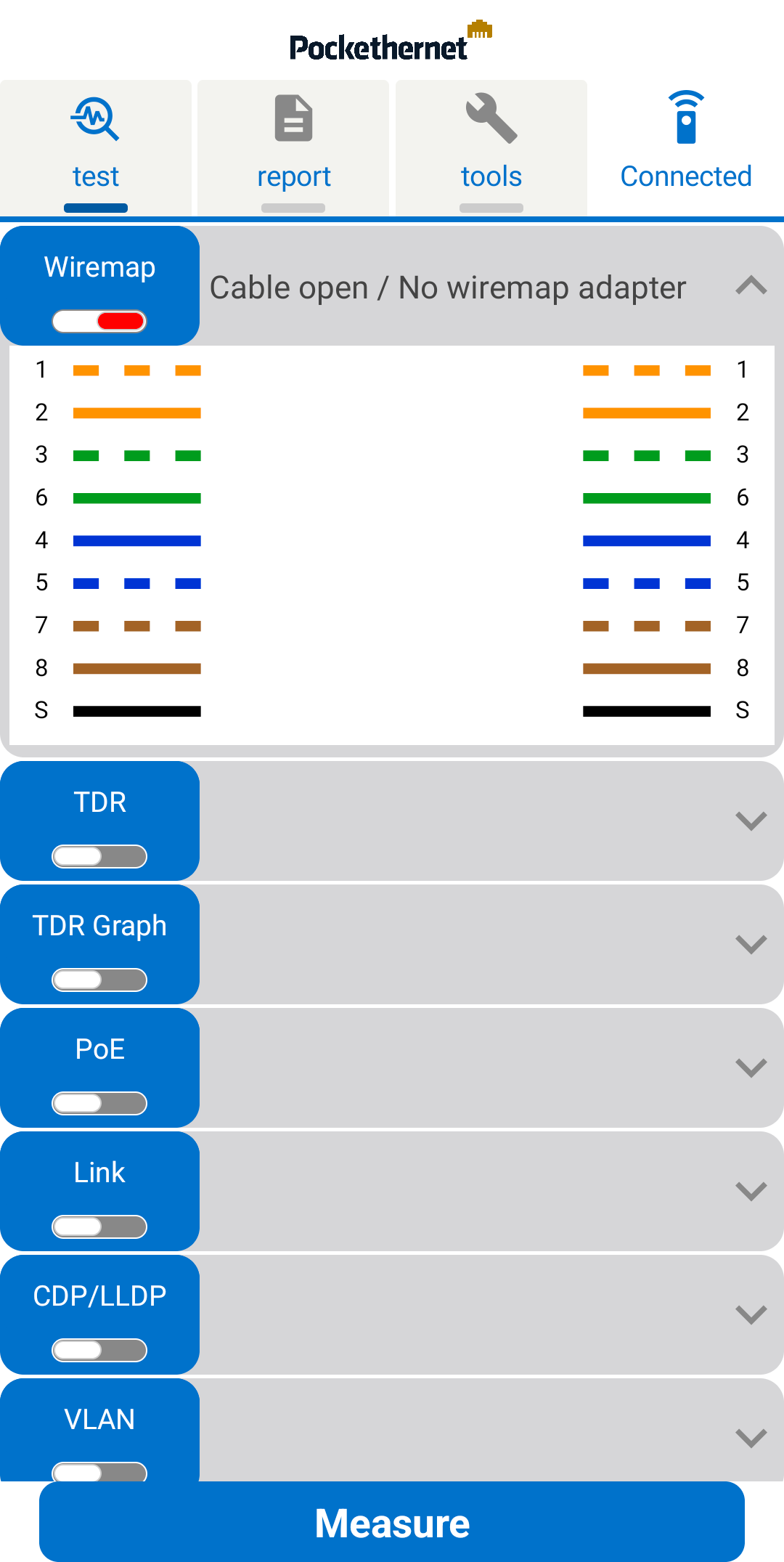
TDR
The TDR-based, single ended length measurement and fault locating tests the physical properties of a cable, with just one end connected to Pockethernet. See how long the cable is and if there are any short circuits or bad terminations. Pockethernet also detects if the cable is connected to a switched off computer or switch.
The main status line shows the overall result of the measurement if each pair in the cable is terminated the same way (e.g. all pairs are open or connected). Else, it will display "Mixed results".
| Status | Result interpretation |
| Open | Cable per not connected to anything |
| Short circuit | There's a short circuit somewhere in the cable |
| Terminated | Cable is connected to a Ethernet port |
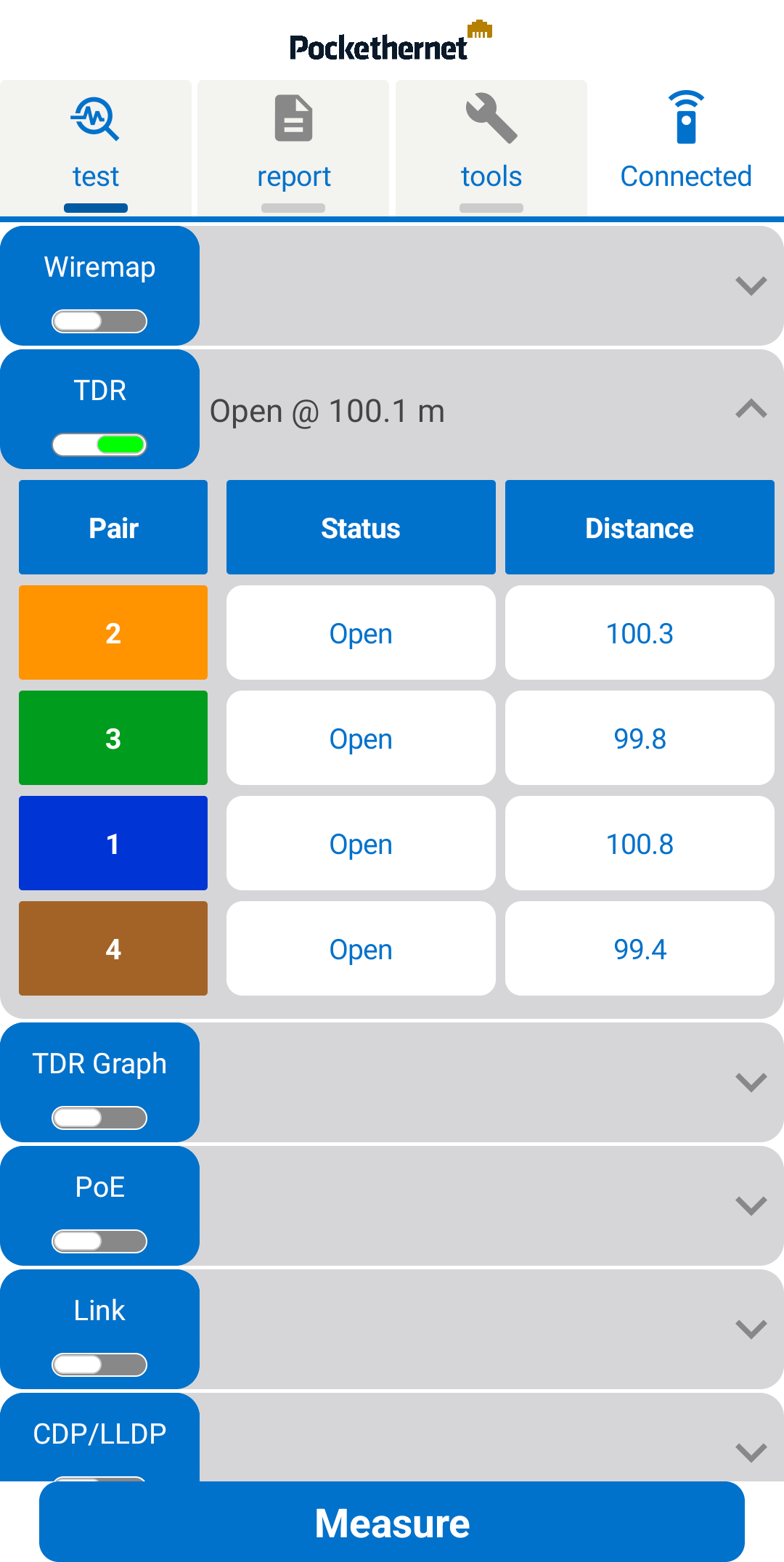
When measuring on an active Ethernet port, the results will be invalid. This is because an active Ethernet port continously transmits signals which interfere with the TDR measurement.
The NVP (Nominal velocity propagation) of the cable can be set in the Settings.
The length cannot be determined if the cable is connected to another Ethernet port, as a properly terminated connection doesn't provide signal reflections that can be reliably measured. You may want to have a look at the TDR Graph where you may be able to identify a small impedance bump as the other Ethernet port.
TDR Graph
This features allows you to see the imperfections of a cable along its whole length. A short electrical pulse is sent down the cable, which is reflected from imperfections (short circuits, split pairs, impedance mismatches, open ends) or absorbed by proper termination (e.g. another ethernet port).
The results of the TDR graph test need some expertise to evaluate. Generally, an impedance mismatch value above +/-20 indicates a cable imperfection that can influece signal and connection quality.
| Impedance mismatch type | Result interpretation |
| Positive | Reflection from open ends |
| Negative | Reflection from shorted ends |
The crosstalk graph gives information about any locations with crosstalk issues.

When measuring on an active Ethernet port, the results will be invalid. This is because an active Ethernet port continously transmits signals which interfere with the TDR measurement.
Example diagnoses using the TDR graph function:
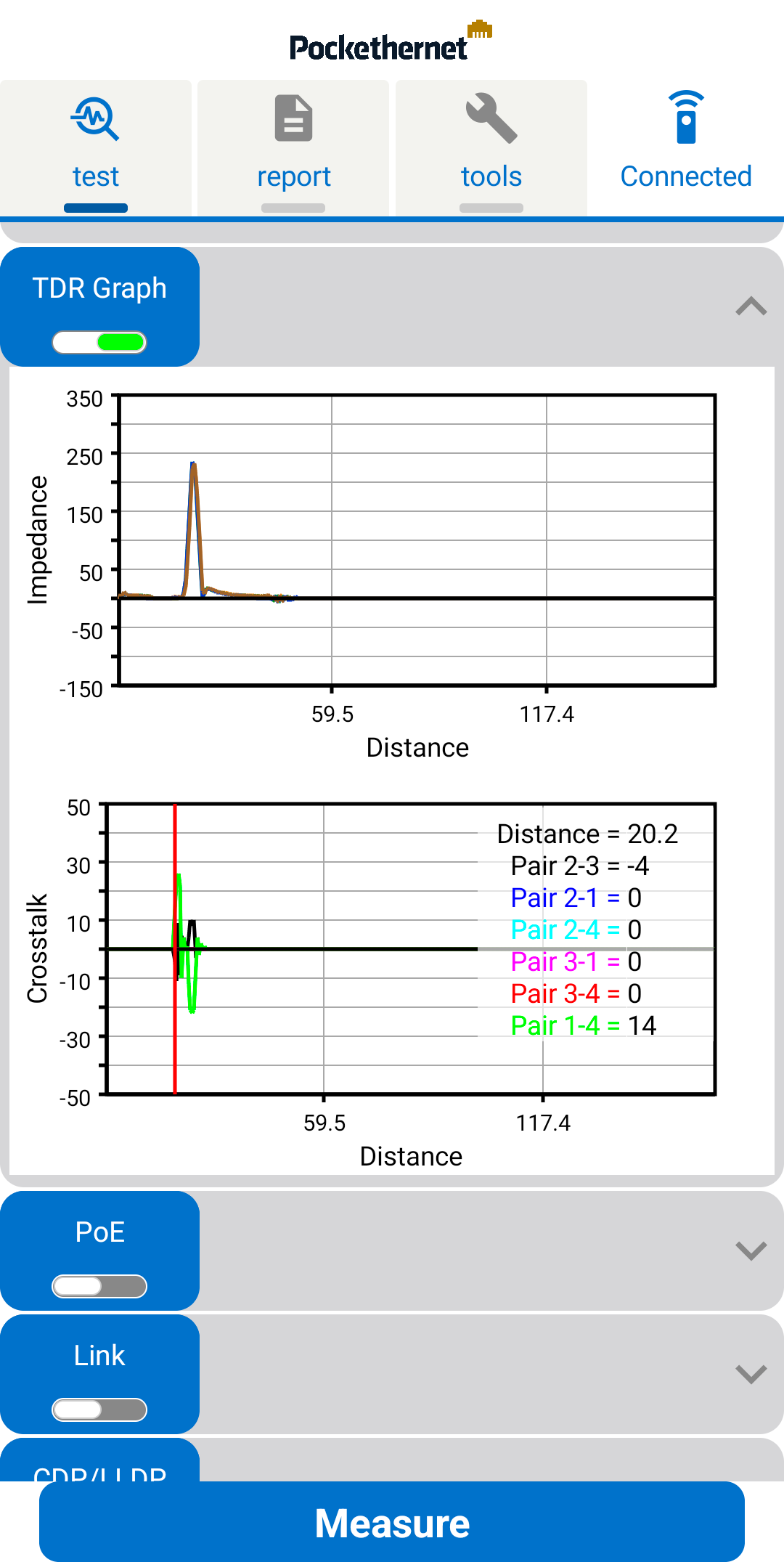
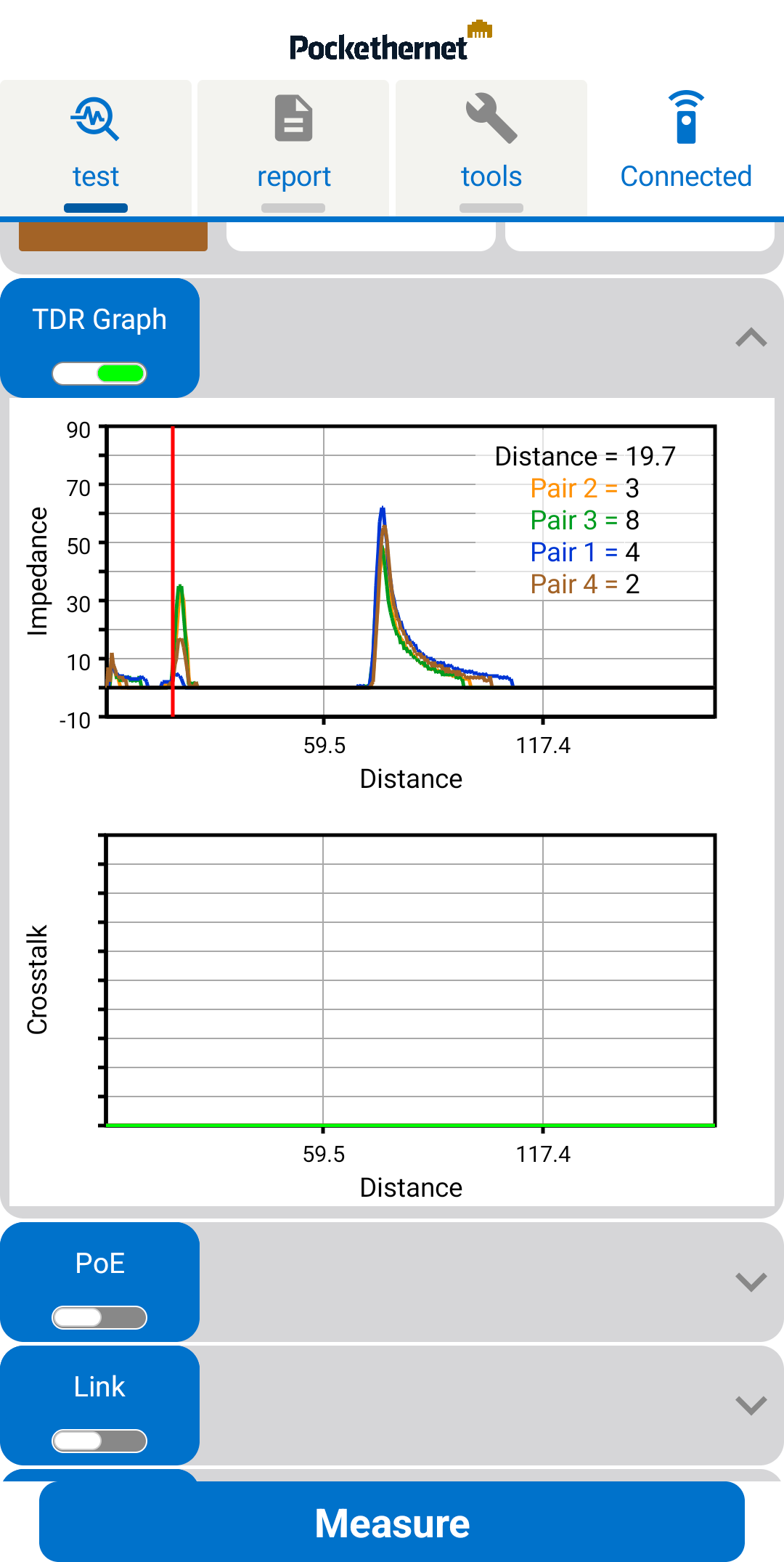
Power over Ethernet (PoE) test
This test verifies the presence of PoE supply on the cable. It detects standard 802.3 AF/AT/BT supplies and passive 'always-on' supplies.
The PSE type is determined along with the open circuit and loaded voltage while also establishing the maximum power class supported/allowed by the PSE.
The test will indicate an error if:
- The open/load voltage is below 37V for an AF/AT power supply
- The open/load voltage is below 42V for a BT power supply
- The difference between the Mode A / Mode B voltage is greater than 10%
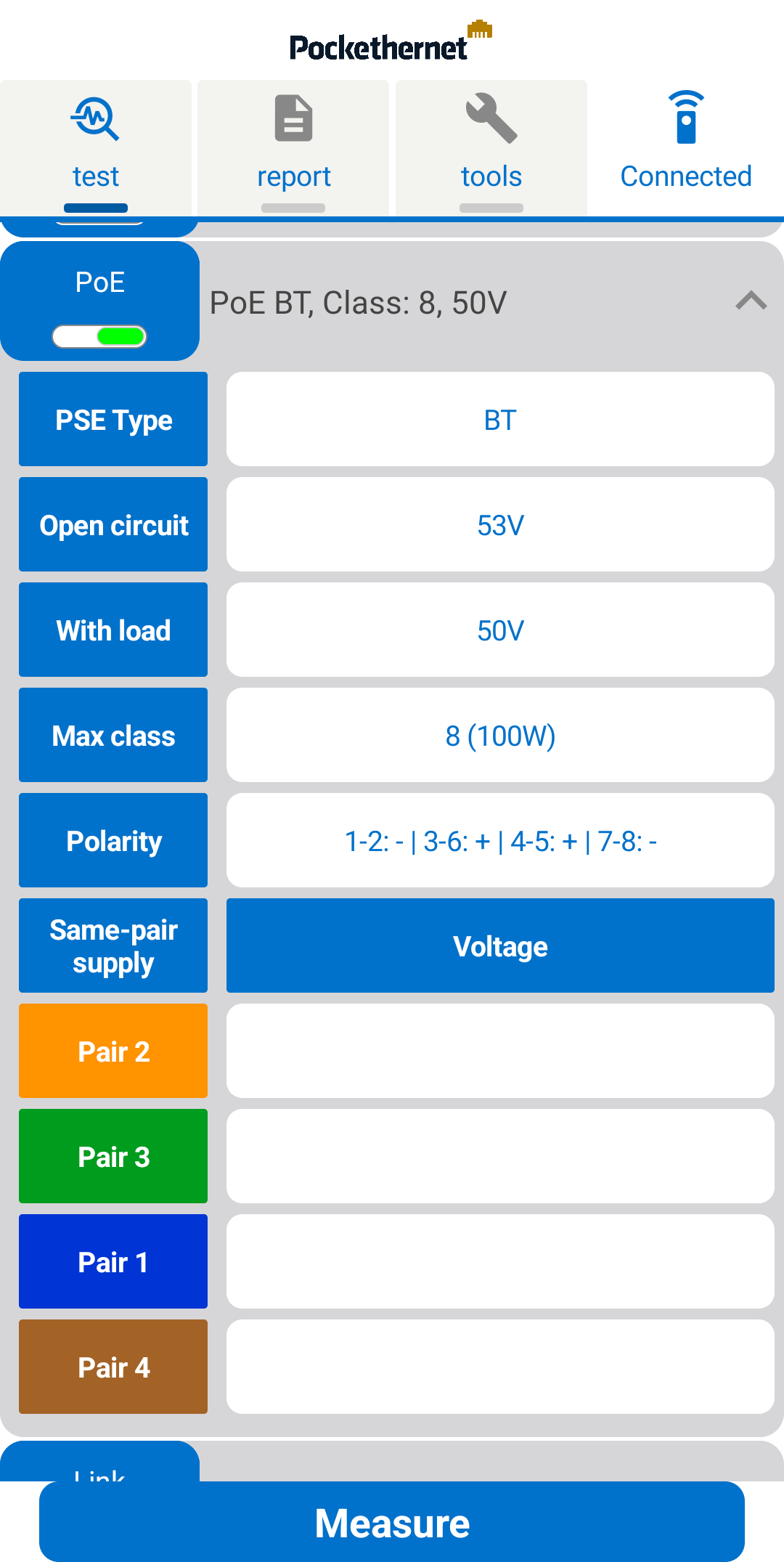
Link test
This test determines if an Ethernet link can be established and what the highest achievable speed is.
If an 1000BASE-T link can be established, the details section will provide information about each link speed advertised by the Ethernet link partner, the polarity of each wire pair and the skew delay for each pair.
The delay skew should be below 56ns per 100m of cable.
The length estimate is calculated based on the link training parameters and gives a very rough estimate (at least +/- 20m error) of the equivalent CAT 5e cable length. Ideally, this shouldn't exceed 100m.
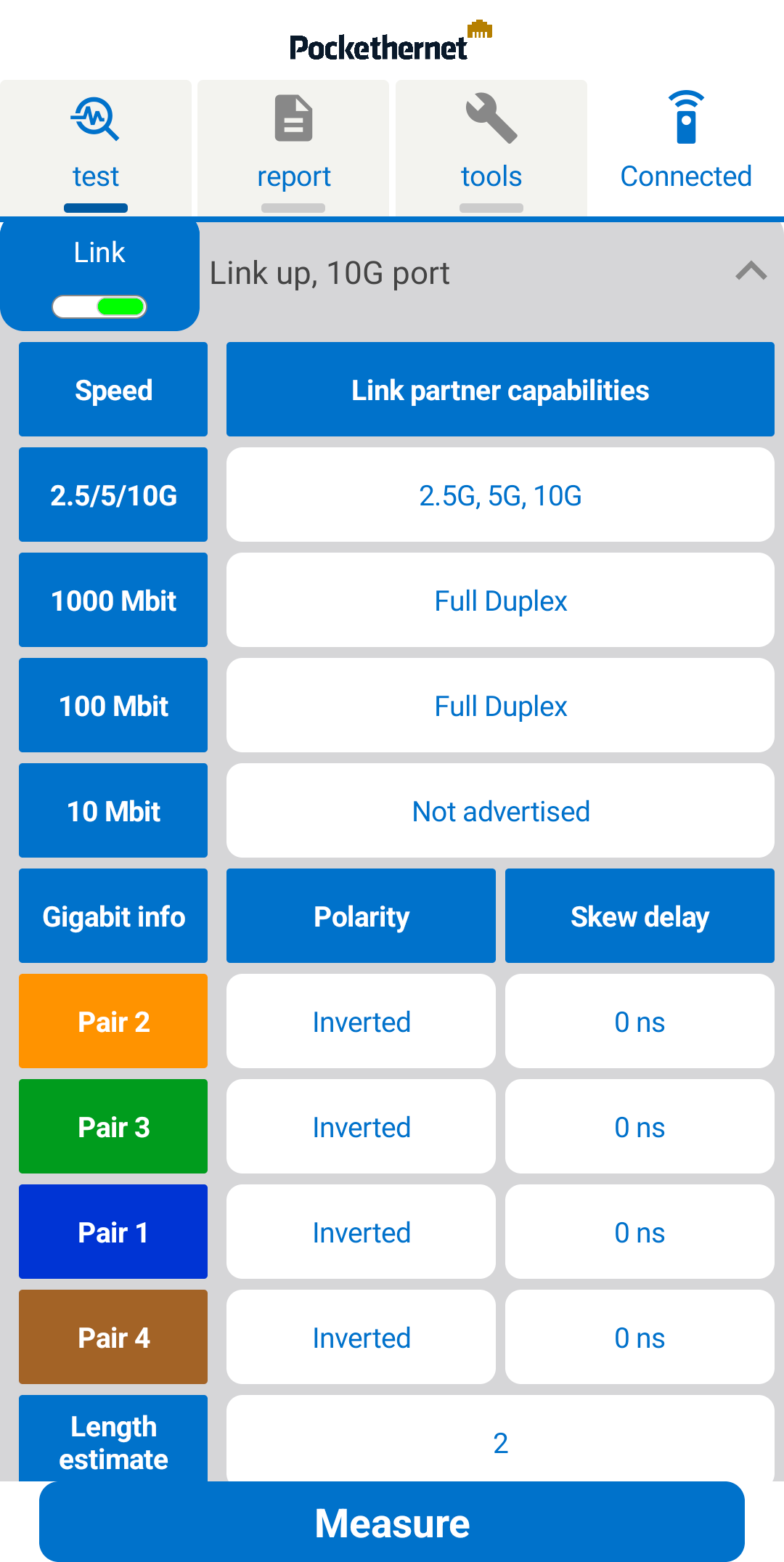
The supported link speeds will be detected by analyzing the Ethernet autonegotiation signaling, up to 10GBASE-T. Pockethernet can only detect speeds actually advertised by a port. The maximum speed at which Pockethernet will establish a link for link-up testing is 1000BASE-T. Actual Ethernet communication for DHCP, ping, etc. will be performed over a 10/100 link.
CDP / LLDP test
When activated, Pockethernet waits for up to 30 seconds after link establishment to receive CDP or LLDP packages.
These diagnostic packages contain information about the connected switch or router, like the physical port ID Pockethernet is connected to, the system name or management IP address. Information fields, called TLVs of the received packet are listed in the details section of this measurement.
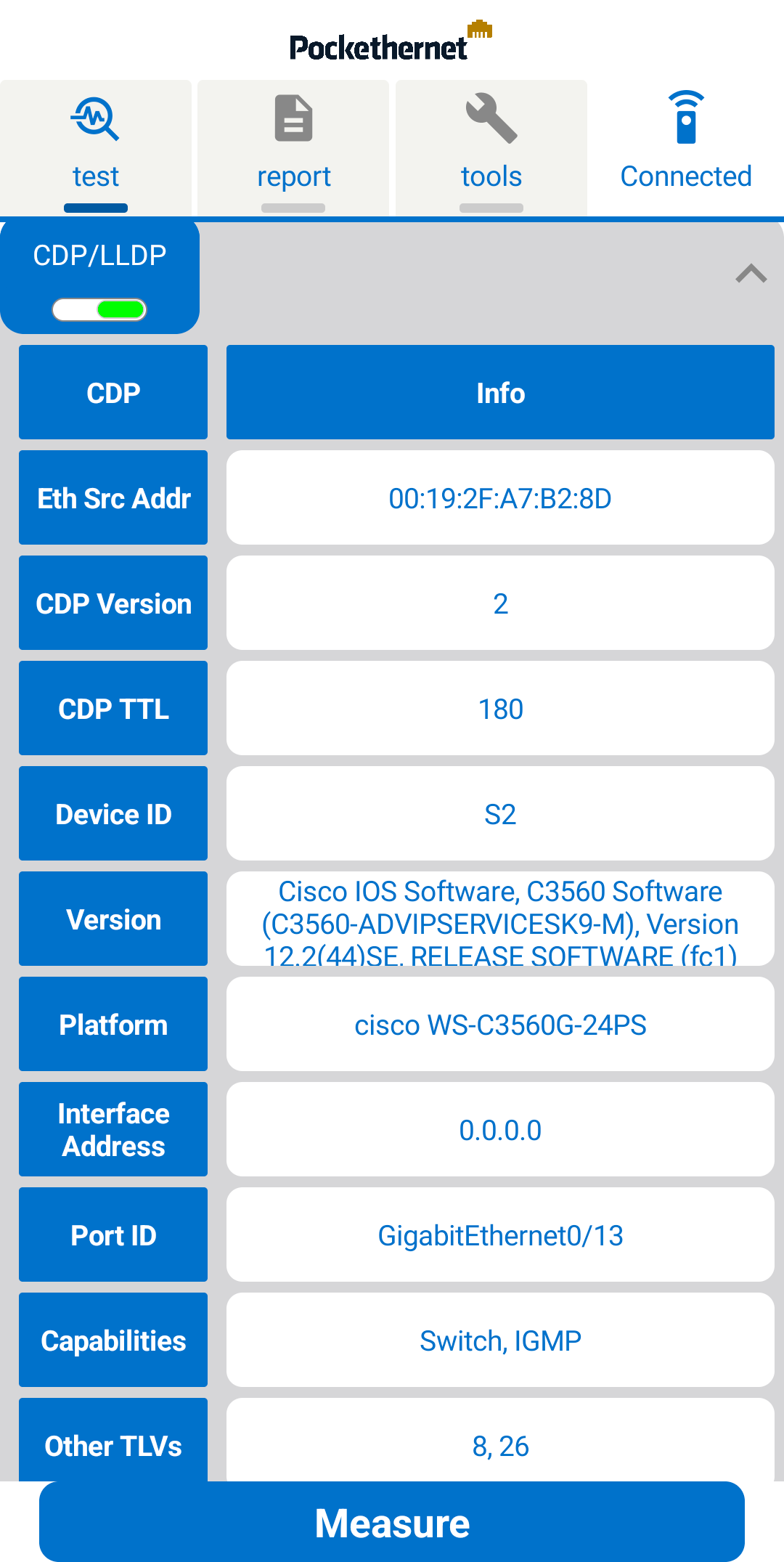
VLAN test
The VLAN test can be used to see any VLANs active on the port or to set the VLAN tags for outgoing packets.
When activated, Pockethernet will wait for 30 seconds for incoming packets and list any detected VLAN tags.
If "Outgoing VLAN tagging" is enabled, any outgoing packets from Pockethernet (DHCP request, Ping, ExtIP) will be tagged so that they are communicated through a specific VLAN.
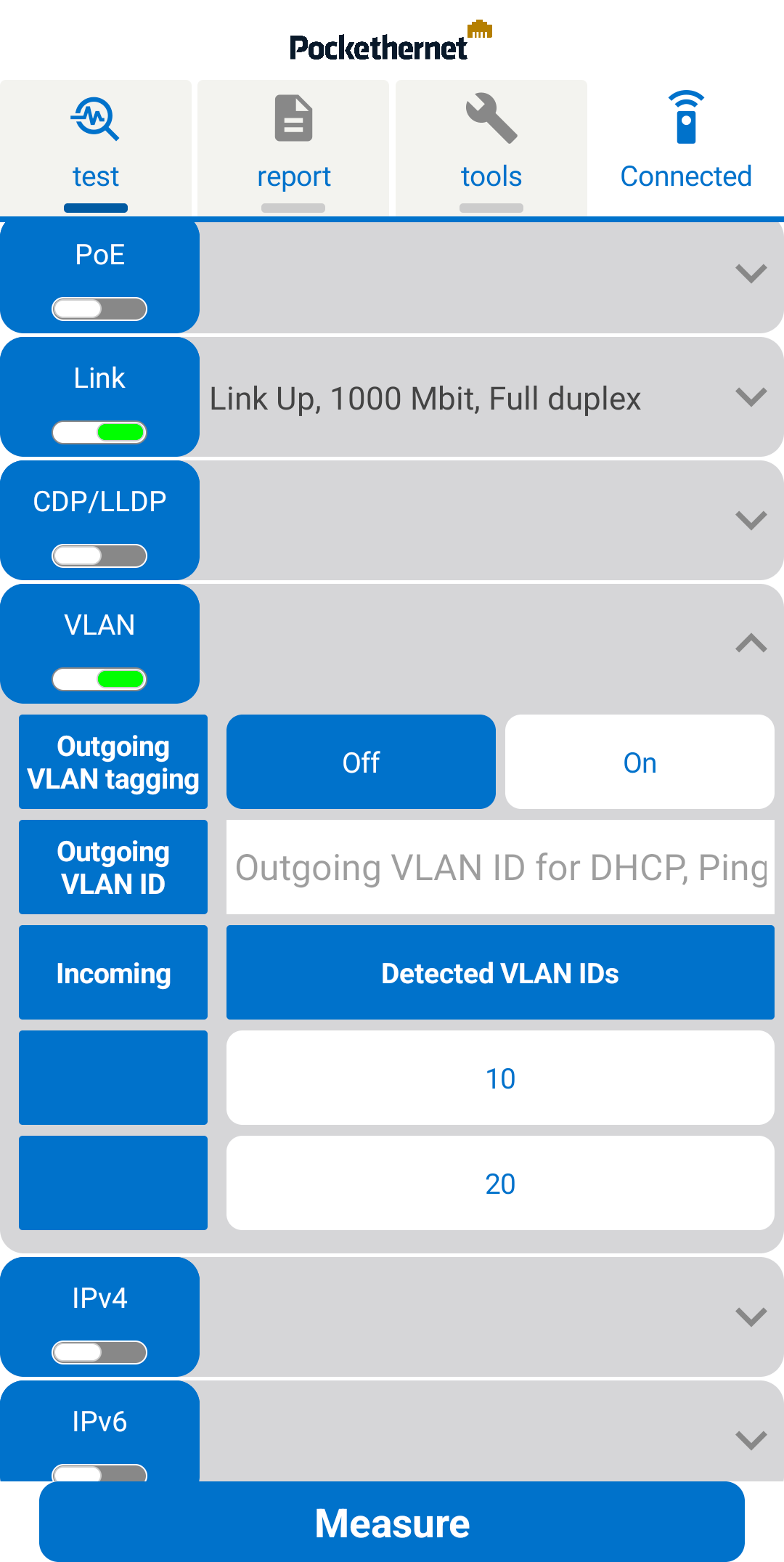
IPv4 (DHCPv4) test
This section allows you to test the networks DHCP settings and make Pockethernet request its IPv4 configuration via DHCP, or you can set up static IPv4 settings to be used for the following tests.
Pockethernet will wait for 30 seconds for a DHCP request to succeed.
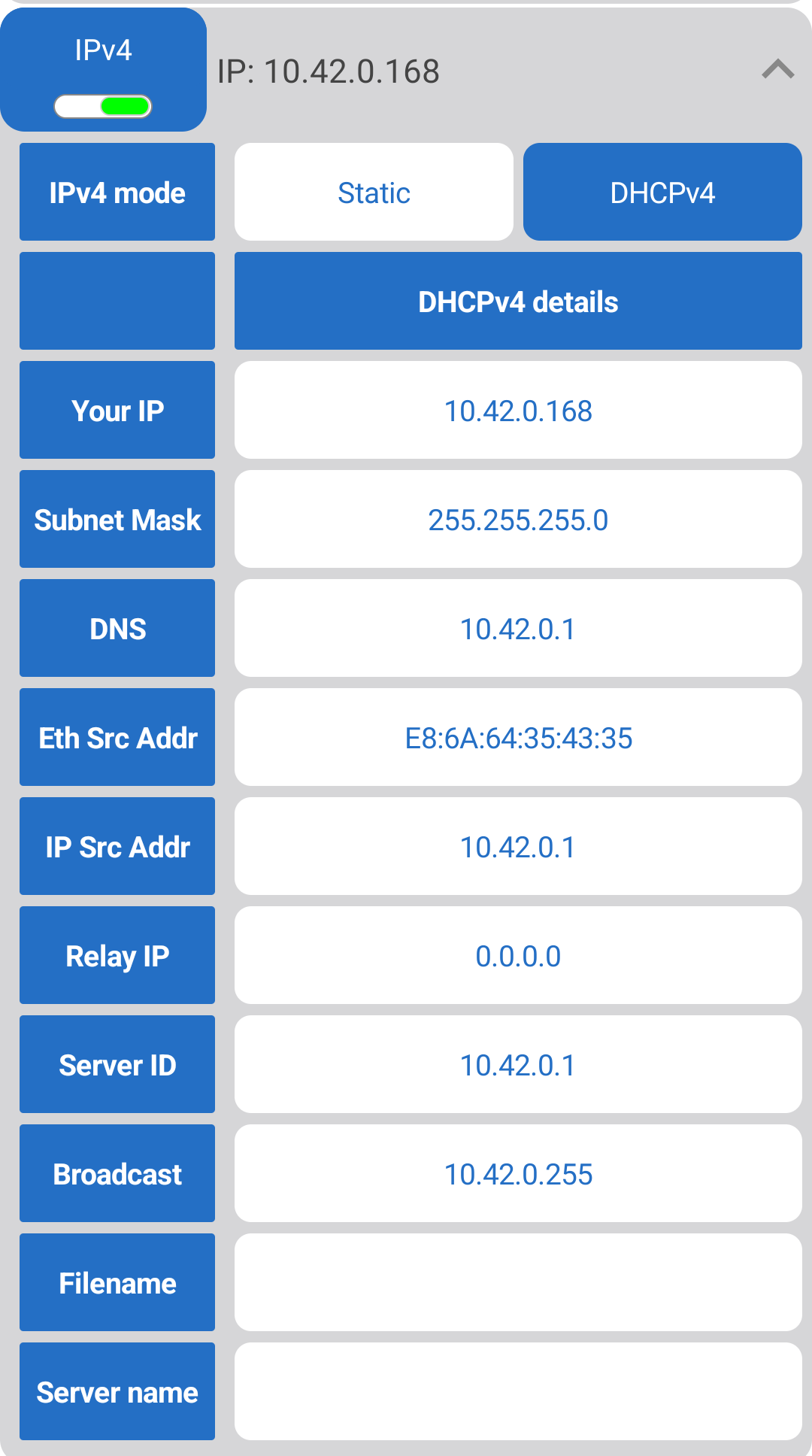
IPv6 (SLAAC/DHCPv6) test
With this test, you can see if IPv6 SLAAC (stateless autoconfiguration) or DHCPv6 is available on the network.
Pockethernet will wait for 30 seconds any Router Advertisement messages needed to establish IPv6 parameters.

Ping test
You can perform ping tets for up to three IP address or domain names
The results include the pinged IP address (so that this test can also be used for DNS resolution) and the average ping time of 3 measurements.
If the ping test is requested, but no addresses are specified, Pockethernet will ping by default (1) the DHCP server, (2) the gateway, (3) the DNS server.
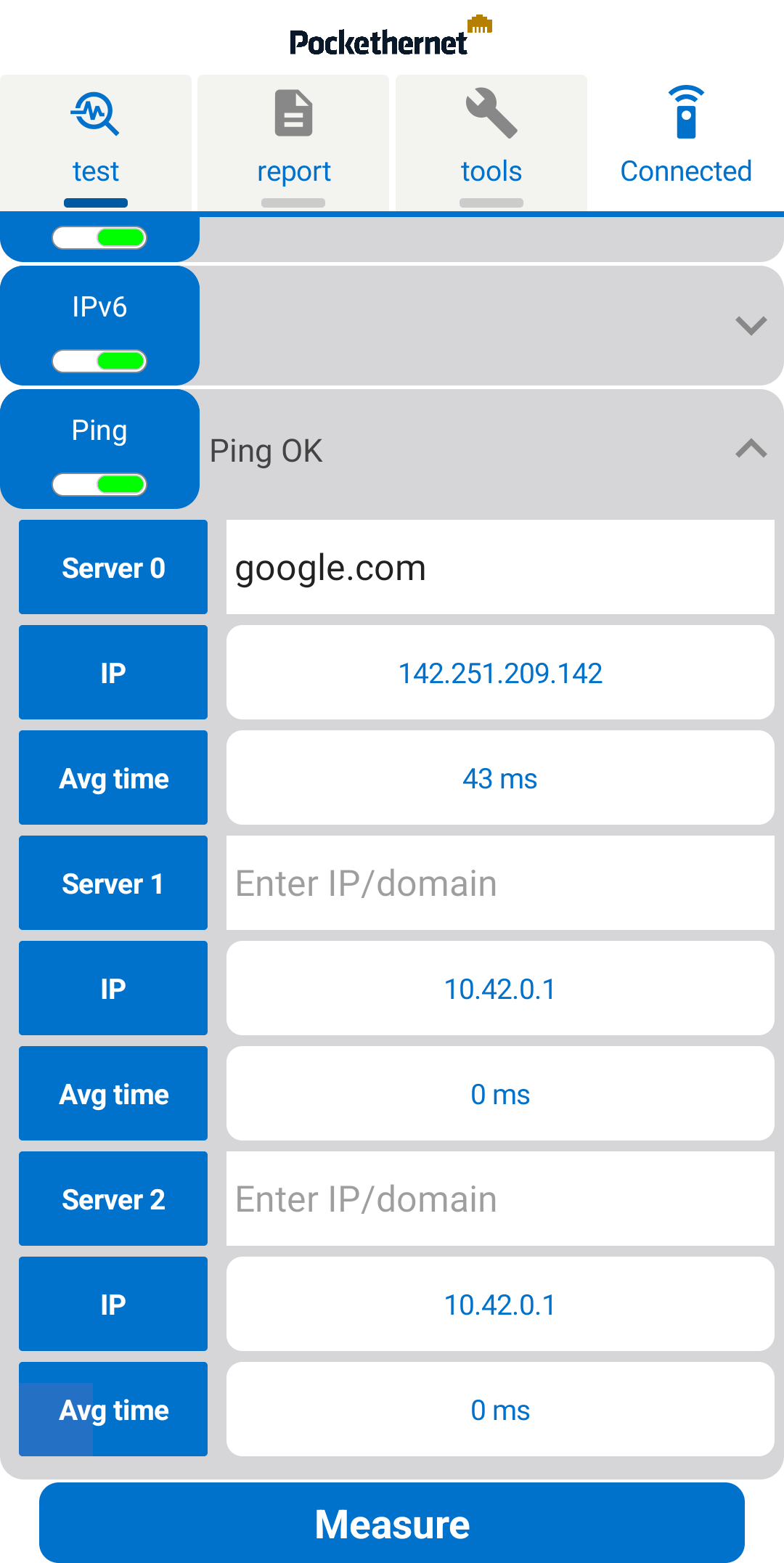
External IP test
With this test, you can check for an Internet connection and see the external IP address of the connection.
Using an external server (provided by ip-api.com), the IP information of your connection will be established, along with the ISP and AS name with an approximate physical location.
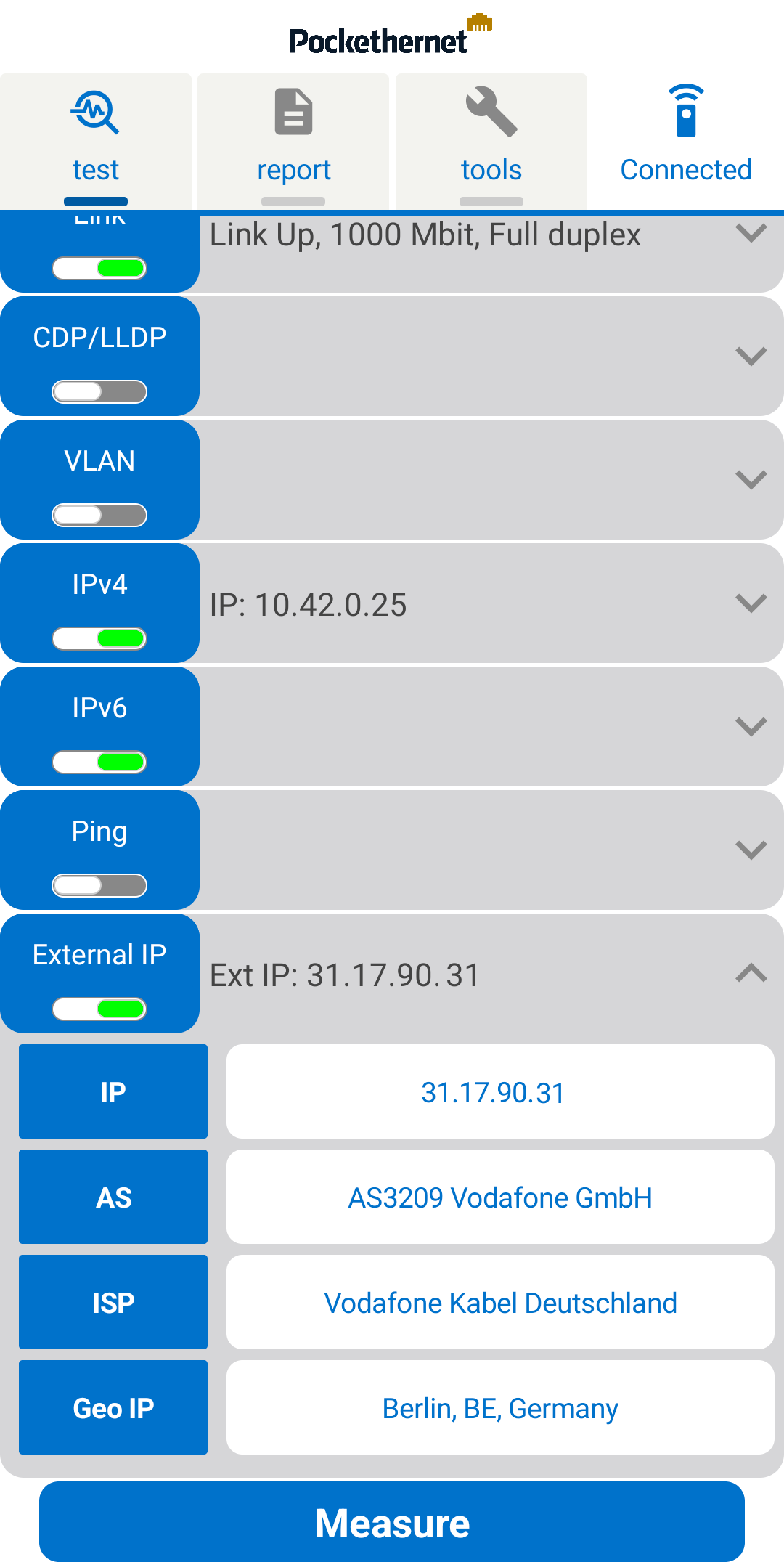
Quick test function
Pockethernet can perform a quick test of the network outlet or cable wihtout the use of the app. This may come handy if you don't have a device with the app installed nearby or simply don't want to launch it and you're only interested in basic network status.
While the device is powered on, connect it to the cable to be tested and press the power button one.
The device will then perform the following tests: Wiremap, PoE, Link, DHCPv4. The results will be indicated via the device LEDs.
Cable & PoE LED:
- Green: Straight through or crossover cable detected. No further tests will be performed as there can't be anything else connected to the cable than the wiremap adapter.
- Yellow: Cable open
- White: Short circuit. Either a fault or an Ethernet port connected
- Blue: PoE supply detected
Link LED:
Green if a 10-1000M link detected, stays unlit otherwise
Network LED:
Green if a DHCPv4 address obtained, stays unlit otherwise
Frequently Asked Questions
The app can't connect via Bluetooth with "Error connecting"
This is reported by the Pockethernet v1 app. Make sure to use the "Pockethernet 2" app with the v2 device.
The device doesn't turn on
Perform a hard reset: With the USB power not connected, press and hold the power button for 20 seconds
During the firmware update, the app reports "Update Error: No Ethernet Link" although the device is connected to a live Ethernet port.
The firmware update needs to establish a 10 Mbit link. Multi-Gbit port don't support 10M links. Use a max 1G port for the update.
Notices
Make sure you read and understand the below notices.
Important safety instructions
Safety precautions
- To prevent fire or shock hazard, avoid exposing this unit to rain or moisture.
- Do not attempt to service this unit yourself. Please refer all servicing to your distributor / retailer.
- Do not open or disassemble the device. There are no user serviceable parts.
- Do not use strong or abrasive detergents when cleaning the device.
- Indoor use only.
- Risk of fire, explosion, and burns. Do not disassemble or crush.
- Use a certified power adapter only. Voltage and current requirement for charging and operation is 5V at 1A.
- Do not use the USB and the Ethernet connector at the same time (unplug Ethernet while charging)
- The device must only be connected to a Network Environment 0 per IEC TR62102
- Do not connect to cables that are routed outside of a building
- Do not connect to telecommunication networks or cable distribution systems
- Risk of explosion if battery is replaced incorrectly
- Dispose of used battery according to regulations
This device complies with part 15 of the FCC Rules. Operation is subject to the following two conditions: (1) This device may not cause harmful interference, and (2) this device must accept any interference received, including interference that may cause undesired operation. This Class B digital apparatus complies with Canadian ICES-003. This equipment has been tested and found to comply with the limits for a Class B digital device, pursuant to Part 15 of the FCC rules. These limits are designed to provide reasonable protection against harmful interference in a residential installation. This equipment generates, uses and can radiate radio frequency energy and, if not installed and used in accordance with the instructions, may cause harmful interference to radio communications. However, there is no guarantee that interference will not occur in a particular installation. If this equipment does cause harmful interference to radio or television reception, which can be determined by turning the equipment off and on, the user is encouraged to try to correct the interference by one or more of the following measures: Reorient or relocate the receiving antenna. Increase the separation between the equipment and the receiver. Connect the equipment into an outlet on a circuit different from that to which the receiver is connected. Consult the dealer or an experienced radio/TV technician for help.
Disposal and Recycling InformationWhen this product has reached the end of its useful life, please dispose of it according to your local environmental laws and guidelines and take it to a collection point designated by local authorities. Some collection points accept products for free. The separate collection and recycling of your product at the time of disposal will help conserve natural resources and ensure that it is recycled in a manner that protects human health and the environment.
DisclaimerThis manual has been compiled and published covering the latest product descriptions and specifications. The contents of this manual and the specifications of this product are subject to change without notice. We reserve the right to make changes without notice in the specifications and materials contained herein and shall not be responsible for any damages (including consequential) caused by reliance on the materials presented, including but not limited to typographical and other errors relating to the publication.